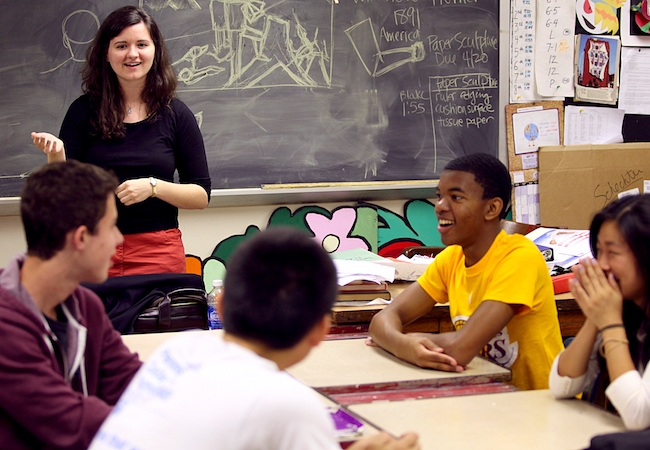The BPR High School Program invited student writers from Providence-area public schools to research, draft, and edit a college-level opinion article over the course of Fall 2023. A special thank you to the editor on this piece, Bianca Rosen ‘25!
Dylan Flynn is a junior at East Providence High School.
Mrs. Smith, standing at the front of the classroom, poses a discussion question to her tenth-grade Honors English class and is met with an impenetrable wall of silence. When entering the classroom, students are buzzing with chatter. Even during class, students whisper to one another about the upcoming dance and text about the nominees for prom court. But once she directs a question to the room, students seem to be at a loss for words.
What they lack in in-class participation, students make up for with constant, compulsive activity online. Ninety-five percent of teenagers report using YouTube, with around 75 percent saying that they use it on a daily basis. Sixty-seven percent of teens use TikTok and 59 percent use Snapchat; out of teenage Snapchat and TikTok users, 86 percent reported that they used the app every day.
The impact of this constant internet usage is seeping into educational spaces. In particular, it deters students from engaging in political discourse with people who hold views in opposition to their own. It is essential that schools encourage students to become more informed citizens who can confidently express their viewpoints in the classroom.
It is already difficult for teachers to get students talking, even about the most basic of subjects. That challenge is magnified when it comes to discussing politically charged topics.
Modern teenagers are uniquely interconnected. They are linked through social media in innumerable ways and on an unprecedented scale. By virtue of their virtual proximity, they know what is being said about them, their friends, and their peers. Now more than ever, words have consequences—and teenagers worry about facing backlash for their views.
Students are concerned that their peers will misconstrue their words in the classroom on social media, leaving them vulnerable to harassment. As a result, they are becoming increasingly afraid of discussing controversial issues. This culminates in the abandonment of open debate out of fear of social repercussion, or being ‘canceled.’
While there is an opinion drought in the classroom, on social media, there’s a deluge. People are simply more emboldened with a screen to their faces. This is, in part, because social media provides several degrees of separation between users, allowing them to share their thoughts on the internet with less fear of repercussion. Online users are not obligated to respond to people who might challenge their ideas. Not only can they choose not to respond but they can also censor opposing views. Most prominent social media platforms like TikTok and Instagram allow their users to delete comments and bar users from visiting their pages.
In a classroom surrounded by people with differing perspectives, teenagers have to be more careful about what they say. There is no anonymity or ability to censor criticism, leaving them more vulnerable to opposition and judgment.
On social media, teenagers are consistently exposed to people who hold similar viewpoints. Ideological echo chambers primarily show them content and media that mirrors their personal tastes. Social media algorithms tailor a user’s content ‘feed’ to their perspectives, reinforcing existing beliefs. Save for the occasional critic, users are typically insulated from having their ideas countered or opposed. More than that, they are validated online for sharing an opinion that a majority of other viewers agree with, receiving likes and supportive comments.
Because students rarely have to defend their point of view to people who disagree with them online, they may be reluctant to share their ideas in class or confront another person with an alternative view.
Increased social media usage is also correlated with increased social anxiety: As students become more active in the online world, they become more terrified at the prospect of being judged by their peers, causing them to avoid political debates and public speaking.
Growing intolerance and polarization make it even harder for students to voice their political views in the classroom. Climate change, for instance, used to be an issue of concern among Democrats, Republicans, and Independents alike. However, starting in the 1990s, the issue split along partisan lines as influxes of money from fossil fuel corporations deteriorated bipartisan climate regulations. Dozens of other issues, like abortion and Covid-19, experienced similar shifts. With viewpoints on individual issues being tied to broader political ideologies, students may fear their peers’ resentment for taking an unpopular stance.
So, how can we resolve this issue? How do we create environments for teenagers that are conducive to meaningful discourse on controversial subjects?
In school, teachers can introduce diverse perspectives to their students and promote group discussions. They can encourage respectful, student-led discourse to foster insightful conversations about sensitive subjects.
Ultimately, though, it is our responsibility as students to be proactive in our own education. We must interact with our teachers and especially with our fellow classmates. The more students voice their opinions, the more engaged and fun class will be. We have to learn how to create a space where students can share their views without fear of judgment from others—without the anonymity and protections that social media provides.
